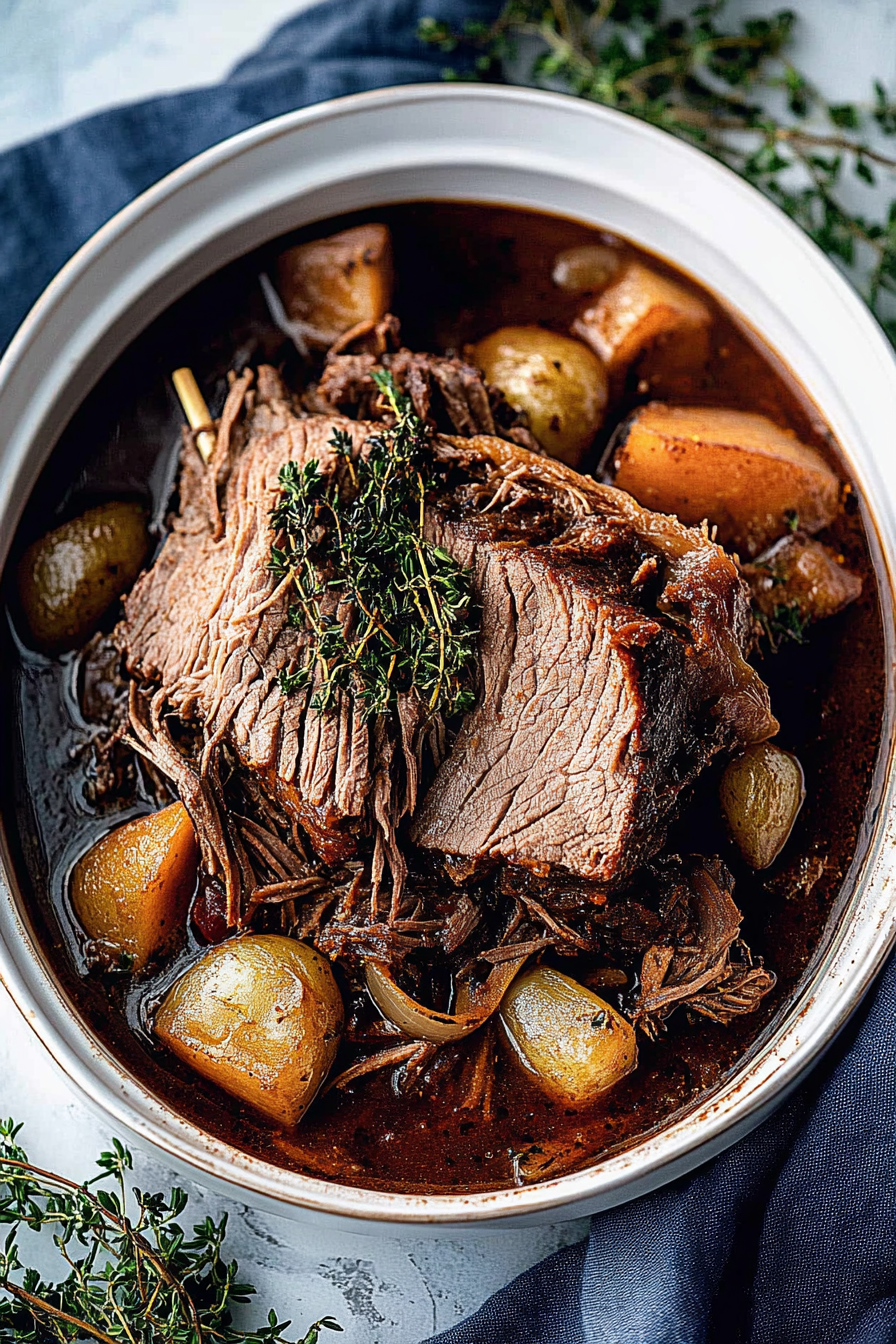Mastering pot roast
Pot roast is a comforting and hearty dish loved by home cooks for its rich flavor and tender texture. This recipe uses a 3.5 to 4-pound beef chuck roast, which is slow-cooked to fork-tender perfection in a flavorful blend of red wine, beef stock, fresh herbs, and aromatic vegetables. The slow cooking method breaks down the connective tissues in the meat, making it melt in your mouth while infusing it with the savory broth and ingredients it cooks with. Pot roast is both a classic and versatile dish that fits perfectly on family dinner tables or special occasions alike.
What makes this recipe a great choice is its simplicity combined with deep, complex flavors that come from traditional cooking techniques such as searing and braising. The use of fresh herbs like thyme and parsley enhances the aroma and taste, while root vegetables like carrots, parsnips, and potatoes add natural sweetness and texture. Whether prepared in the oven or slow cooker, this pot roast recipe offers a satisfying, complete meal in one pot.
Though this dish is not vegan or gluten-free by default, substitutions can be made to accommodate a range of dietary needs. With minimal active prep time and mostly hands-off slow cooking, pot roast allows you to enjoy homemade goodness without complicated steps.
Benefits and Advantages of pot roast
Ease of Preparation and Convenience
This pot roast recipe stands out for its straightforward preparation, perfect for home cooks of any experience level. After seasoning and searing the beef, the recipe mainly involves combining ingredients in a single pot to slow-cook in the oven or a slow cooker. This hands-off approach frees you to focus on other tasks, making it excellent for busy days or entertaining without stress.
Rich Flavor Development
The slow braising process deeply infuses the beef with bold flavors from red wine, tomato paste, fresh herbs, and root vegetables. The caramelization during searing adds a beautiful depth and complexity to the meat and sauce, creating a savory dish that delights the palate.
Nutritional Benefits
Beef chuck roast is a great source of high-quality protein, iron, zinc, and B vitamins essential for energy and muscle repair. Paired with nutritious root vegetables, this meal offers fiber, vitamins, and antioxidants. Using olive oil for searing contributes heart-healthy fats. Making this dish at home lets you control the seasoning and fats, supporting balanced nutrition.
Versatility and Comfort
- Can be cooked in an oven, Dutch oven, or slow cooker to suit your preference.
- Perfect for family dinners, meal prepping, or holiday gatherings.
- Pairs well with mashed potatoes, noodles, or fresh bread.
- Offers flexibility to swap vegetables or herbs seasonally or according to taste.
This recipe combines convenience, nourishment, and flavor, making it a stand-out choice for anyone seeking a comforting home-cooked meal. For a related hearty dish, try our Crock-Pot Pot Roast.
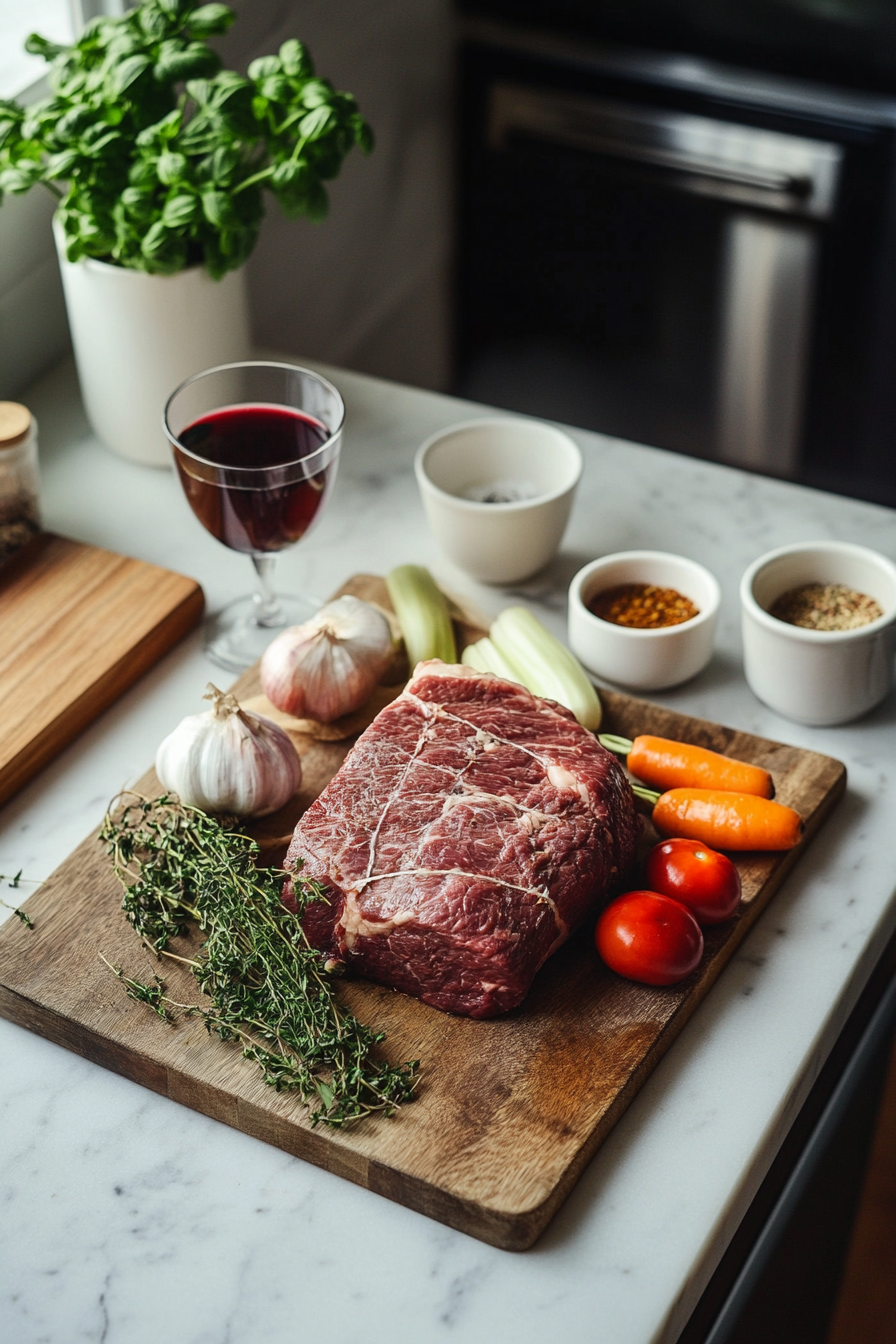

Essential Ingredients for pot roast
Below is a detailed list of all ingredients with precise measurements and notes on their contributions to flavor and texture. Dietary tags are noted where relevant.
- 3½ to 4 lb. beef chuck roast – ideal cut for tenderness and marbling
- Salt and freshly cracked pepper – for seasoning the meat and vegetables
- 2 tablespoons olive oil – for searing; provides healthy fat and flavor (vegan, gluten-free)
- 1 yellow onion, peeled and julienned – aromatic sweetness
- 2 leeks (white and yellow parts only), thinly sliced – mild onion flavor
- 6 garlic cloves, thinly sliced – savory depth
- 1 cup red wine (cabernet sauvignon, merlot, or shiraz recommended) – deglazes pot and enriches flavor (can substitute with beef stock or non-alcoholic alternatives)
- 3 tablespoons tomato paste – adds umami and thickness
- 6 cups beef stock – braising liquid, tenderizes meat (check gluten-free label as needed)
- 2 bay leaves – herbal aroma
- 8 to 10 sprigs fresh thyme – earthy herbal flavor
- 8 to 10 fresh parsley stems with leaves – fresh herbal notes
- Optional: 3 sprigs fresh rosemary – piney aroma
- 2 lb baby Yukon potatoes – tender and creamy texture
- 6 to 8 whole carrots, cut into 2-inch pieces – sweetness and color
- 4 ribs celery, cut into 2-inch pieces – subtle bitterness and crunch
- 2 peeled parsnips, cut into 2-inch pieces – unique earthy sweetness
- 1 peeled rutabaga, cut into 1-inch cubes – hearty root vegetable flavor
- Optional: ½ cup red wine vinegar, Worcestershire sauce, garlic powder, button mushrooms – additional layers of flavor
- Coarse salt and freshly cracked pepper – to taste
- All-purpose flour and softened unsalted butter – for beurre manié thickener (replace with cornstarch for gluten-free option)
Dietary Substitutions to Customize Your pot roast
Adjust this pot roast recipe easily to accommodate dietary preferences, ingredient availability, or to experiment with new flavors.
Meat and Protein Substitutions
- For vegan or plant-based diets, substitute beef with hearty vegetables like portobello mushrooms, lentils, or seitan, and use vegetable stock instead of beef stock.
- Alternative beef cuts like brisket, sirloin, or top round can be used, though cooking times may vary slightly. Choose cuts with good marbling and connective tissue for best tenderness.
Gluten-Free Options
- Use certified gluten-free beef stock and Worcestershire sauce or substitute with tamari.
- Replace all-purpose flour with cornstarch or arrowroot powder for thickening the sauce.
Alcohol-Free and Low-Sodium Adaptations
- Substitute red wine with extra beef stock, grape juice diluted with vinegar, or dark non-alcoholic beer.
- Reduce salt and use low-sodium broth to better control sodium intake.
Vegetable Variations
- Seasonally swap root vegetables with sweet potatoes, turnips, or butternut squash.
- Add mushrooms or pearl onions for more texture and flavor.
These flexible substitutions ensure the pot roast remains flavorful and enjoyable while catering to various diet needs. For slow cooker tips and other variations, visit our Pork Rib Soup with Corn and Mushrooms.
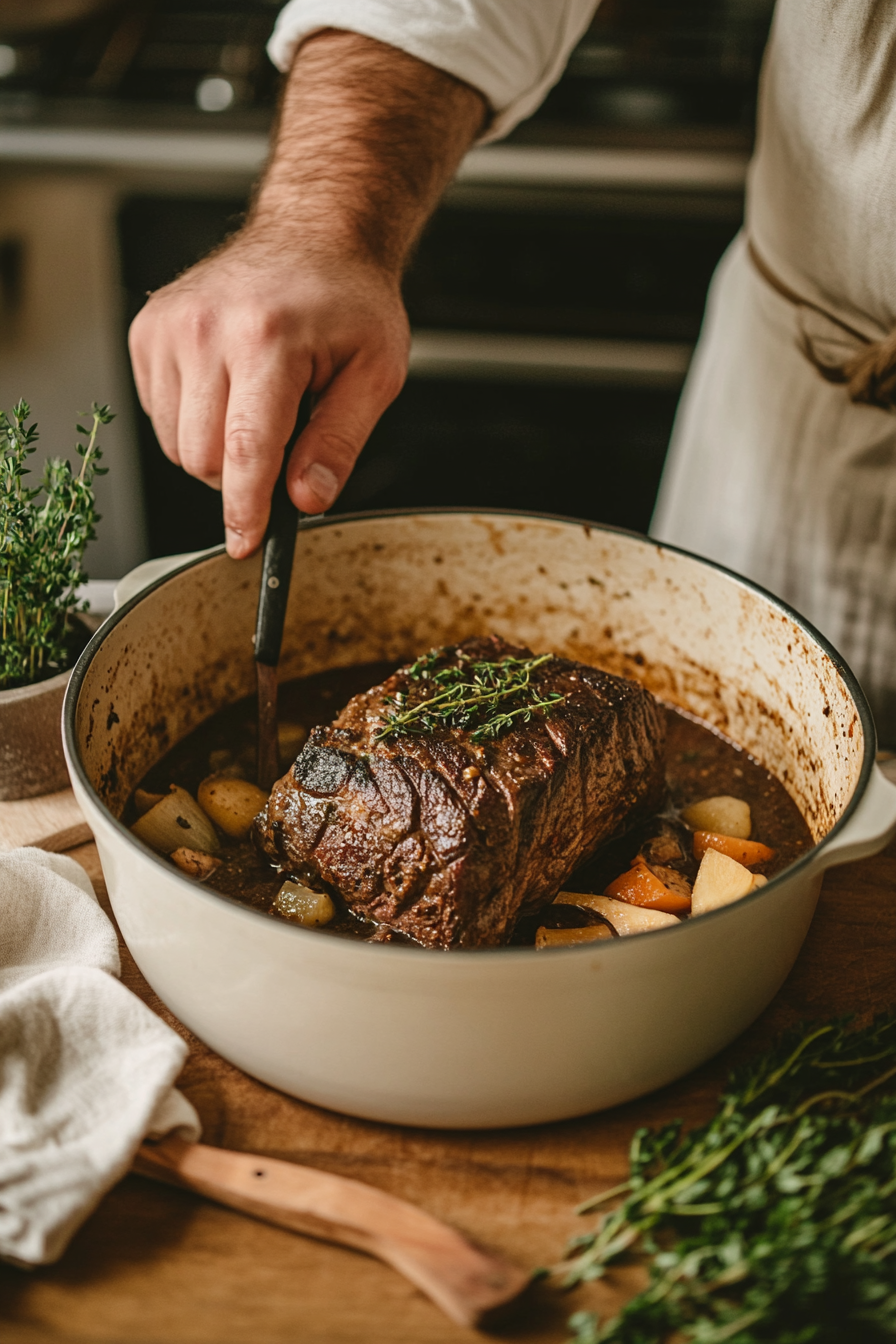

How to Prepare the Perfect pot roast: Step-by-Step Guide
Preparing the perfect pot roast involves a series of carefully executed steps that transform a well-marbled beef chuck roast into a tender, flavorful centerpiece. Follow this step-by-step guide for an easy and rewarding cooking experience.
First Step: Season and Refrigerate
Generously season a 3 ½ to 4-pound beef chuck roast with salt and freshly cracked black pepper on all sides. Place the roast uncovered on a rack inside a sheet tray and refrigerate it for 12 to 48 hours to allow the salt to penetrate the meat, enhancing flavor.
Second Step: Preheat and Sear
Preheat your oven to 300-325°F (150-165°C). Heat 2 tablespoons of olive oil in a large Dutch oven over medium-high heat. Once hot, sear the beef on all sides until golden brown, about 3 to 4 minutes per side. Remove the beef and set aside; this step builds a flavorful crust.
Third Step: Sauté Aromatics
In the same pot, add 1 peeled and julienned yellow onion and 2 thinly sliced leeks (white and yellow parts only). Season lightly with salt and cook on medium-low, stirring for 4 to 6 minutes until softened and starting to brown. Add 6 thinly sliced garlic cloves and sauté for 30 to 45 seconds until fragrant.
Fourth Step: Deglaze and Add Liquids
Pour in ¼ cup of red wine (cabernet sauvignon, merlot, or shiraz) to deglaze the pot, scraping up browned bits. Cook until the wine is absorbed, then stir in 3 tablespoons of tomato paste and cook for 2 to 3 minutes. Add the remaining ¾ cup red wine, 6 cups beef stock, 2 bay leaves, 8 to 10 sprigs of fresh thyme, 8 to 10 parsley stems with leaves, and optionally 3 sprigs fresh rosemary. Stir well.
Fifth Step: Return Beef to Pot and Braise
Place the seared beef back into the pot. Bring the liquid to a boil, then cover the Dutch oven with a lid and transfer it to the preheated oven. Cook for 3 ½ to 4 hours until the beef is fork-tender and the internal temperature reads 200 to 210°F (93 to 99°C).
Sixth Step: Add Vegetables
About 70 minutes before the end of cooking, add 2 pounds of baby Yukon potatoes, 6 to 8 whole carrots cut into 2-inch pieces, 4 ribs celery cut into 2-inch pieces, 2 peeled parsnips cut into 2-inch pieces, 1 peeled rutabaga cut into 1-inch cubes, and optional button mushrooms. This timing ensures the vegetables become tender without overcooking.
Seventh Step: Thicken Sauce and Final Touches
When the cooking is complete, carefully remove the beef and set it aside to rest. Mix equal parts softened unsalted butter and all-purpose flour to make a beurre manié. Stir the beurre manié into the pot over low to medium heat to thicken the sauce into a rich gravy. Add Worcestershire sauce and ½ cup red wine vinegar if desired to balance flavors.
Eighth Step: Serve
Return the beef to the pot or slice it and serve alongside the vegetables, ladling the thickened sauce over the top. Garnish with minced fresh parsley for a vibrant finish. This hearty pot roast pairs beautifully with mashed potatoes or noodles for a comforting meal.
For further details on cooking techniques, visit How to Cook a Classic Pot Roast.
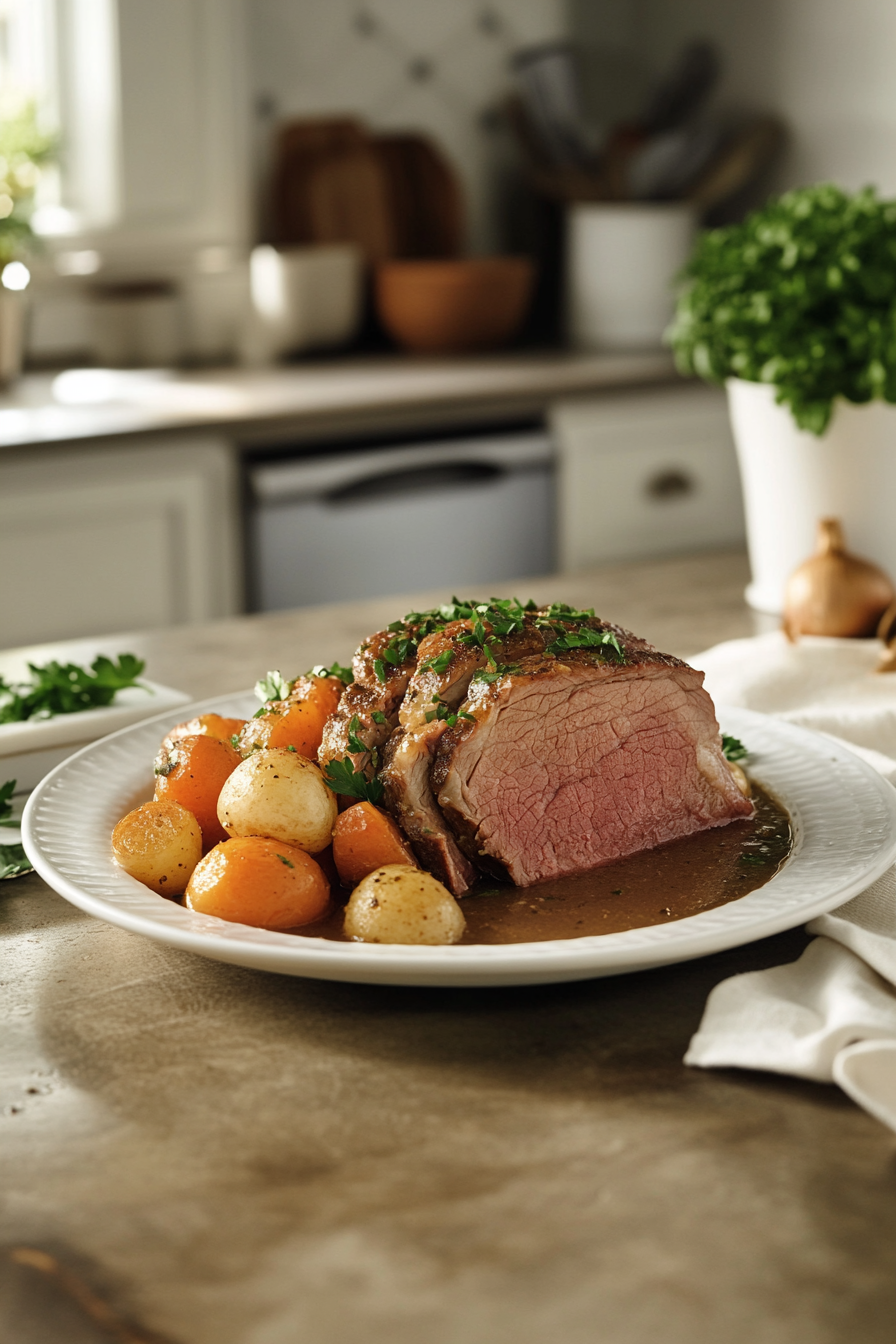

Mastering pot roast: Advanced Tips and Variations
To perfect your pot roast and tailor it to your taste, consider these advanced tips and creative variations.
Tips for Success
- Choose the Right Cut: Use a well-marbled chuck roast for tenderness; marbling renders during cooking to keep the meat juicy.
- Sear Thoroughly: Don’t rush the searing process—browning develops flavor and a beautiful crust.
- Low and Slow: Maintain low oven temperature and cook time to break down connective tissue without drying out the beef.
- Braise Covered: Keep the pot covered to trap steam, which helps tenderize the meat and keeps it moist.
- Rest before Slicing: Let the roast rest for at least 10 minutes post-cooking to reabsorb juices.
Variations to Try
- Additional Vegetables: Add pearl onions, turnips, or mushrooms for more complexity.
- Spice it Up: Incorporate smoked paprika, crushed red pepper flakes, or a splash of hot sauce into the sauce for mild heat.
- Herb Infusions: Experiment with fresh herbs like marjoram or tarragon alongside thyme and rosemary.
- Slow Cooker Method: Use a slow cooker on low for 8 hours for a hands-off alternative, adjusting vegetable timing accordingly.
- Instant Pot Pressure Cooking: For quicker preparation, pressure cook the beef for about one hour, followed by adding vegetables and cooking for an additional 10-15 minutes.
For example, if you prefer slow cooker convenience, see our Crock-Pot Pot Roast recipe with tips for perfect results.
How to Store pot roast: Best Practices
Proper storage of your pot roast ensures flavor retention and food safety for enjoying leftovers.
Refrigeration
- Allow the pot roast to cool slightly at room temperature but no longer than 2 hours after cooking.
- Wrap beef and vegetables tightly or transfer to airtight containers.
- Store in the refrigerator for up to 4 days.
Freezing
- Divide pot roast and vegetables into meal-sized portions.
- Wrap securely with plastic wrap and foil or use freezer-safe containers.
- Freeze for up to 3 months for best quality.
- Defrost overnight in the fridge before reheating.
Reheating Tips
- Reheat gently in a covered saucepan over low heat, adding a splash of beef stock or water to keep moist.
- Avoid microwave reheating as it might dry the meat.
- Serve with fresh herbs to refresh flavors.
Nutritional Value of pot roast
This hearty pot roast recipe provides a well-rounded nutritional profile, rich in protein and essential micronutrients.
| Nutrient | Amount per Serving | Notes |
|---|---|---|
| Calories | 821 kcal | Provides substantial energy |
| Protein | 62 g | High-quality complete protein that supports muscle maintenance |
| Total Fat | 36 g | Contains both saturated and unsaturated fats |
| Carbohydrates | 59 g | Primarily from root vegetables and potatoes |
| Cholesterol | 183 mg | Moderate, consistent with beef dishes |
| Sodium | Varies | Dependent on salt added and broth used |
This nutrient-dense dish supports balanced meals, providing protein, complex carbohydrates, vitamins, and minerals. For additional insights, refer to Nutritional Benefits of Beef.
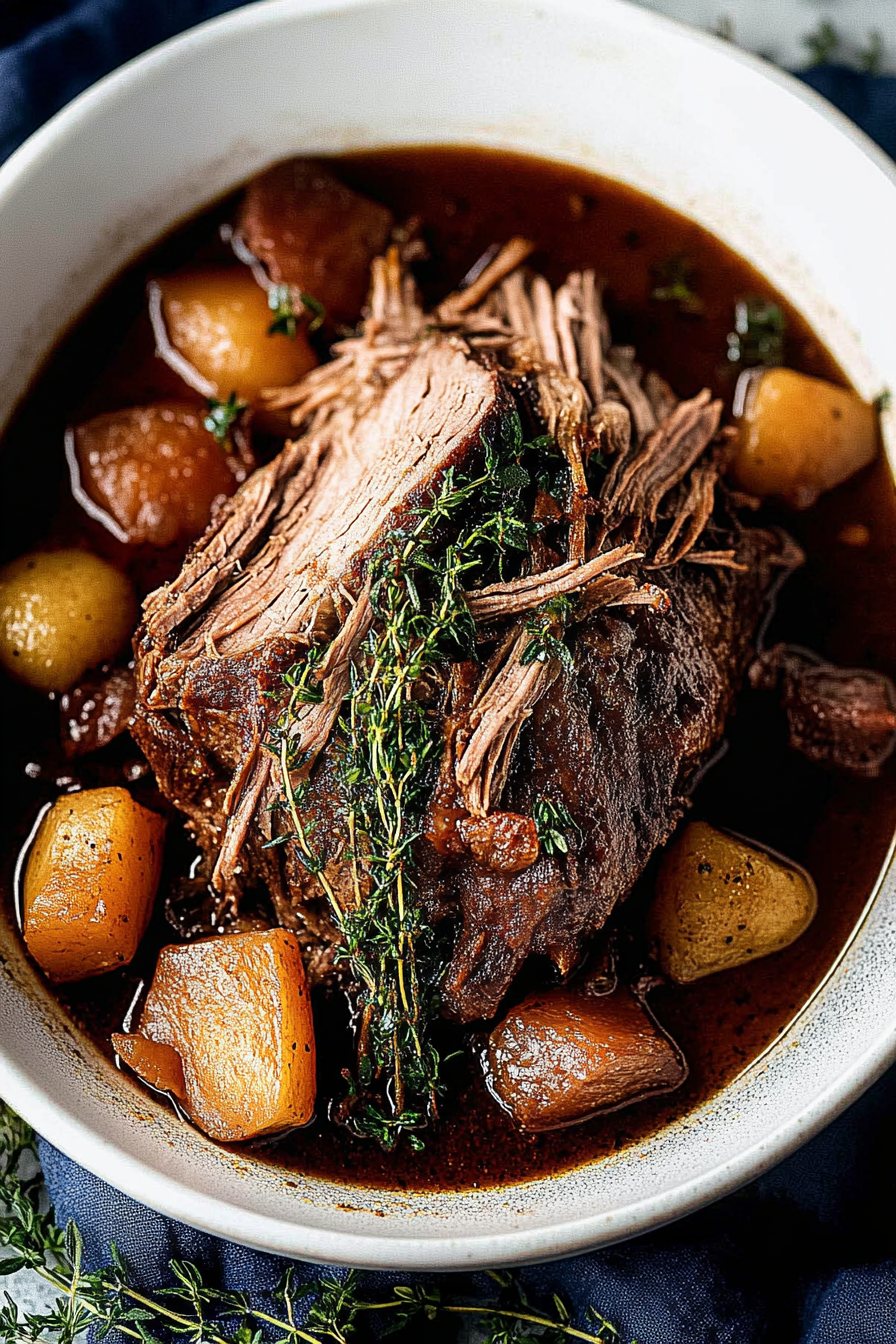

FAQs: Frequently Asked Questions About pot roast
What is the best beef cut for making pot roast?
The preferred cut is beef chuck roast due to its marbling and connective tissue which break down during slow cooking for tender, flavorful meat. Alternatives include brisket and sirloin, with brisket being fattier and sirloin leaner but less forgiving in long cooking.
Which vegetables should I include in my pot roast?
Classic vegetables include carrots, baby Yukon potatoes, and celery. Other good options are parsnips and mushrooms. Carrots add sweetness, potatoes provide creaminess, celery offers aromatic crunch, while mushrooms contribute earthiness.
Can I use a slow cooker instead of the oven for pot roast?
Yes, a slow cooker allows set-it-and-forget-it convenience. Cooking time is longer, usually 8 hours on low. The oven can yield a slightly richer crust from searing but both methods produce tender results.
Should I brown the meat before cooking my pot roast?
Browning the meat enhances flavor by creating a caramelized crust and adds color. While not mandatory, it significantly improves depth of taste. Browning vegetables also boosts aroma and texture.

Hearty and Tender Pot Roast: Classic and Slow Cooker Variations for the Perfect Meal
- Total Time: 4 hours 15 minutes plus refrigeration
- Yield: 6 servings 1x
- Diet: Gluten-Free
Description
🥩 Sink your teeth into a perfectly seasoned and fall-apart tender pot roast that will warm your soul!
🍽 Packed with hearty vegetables and rich flavors, this dish is ideal for family gatherings or cozy meals!
Ingredients
3.5 to 4-pound beef chuck roast
Salt and freshly ground black pepper
2 tablespoons olive oil
1 large onion, sliced
2 leeks, chopped
4 cloves garlic, minced
1 cup red wine
2 tablespoons tomato paste
4 cups beef stock
2 bay leaves
2 sprigs fresh thyme
2 tablespoons chopped fresh parsley
1 pound baby Yukon potatoes
3 carrots, peeled and chopped
2 stalks celery, chopped
2 parsnips, peeled and chopped
1 rutabaga, peeled and chopped
2 tablespoons butter
2 tablespoons flour
1 tablespoon Worcestershire sauce
1 tablespoon red wine vinegar (optional)
Instructions
1. Liberally season the beef chuck roast with salt and refrigerate uncovered for 12 to 48 hours.
2. When ready to cook, preheat the oven to 325°F and season the roast with freshly ground black pepper.
3. In a large Dutch oven, heat olive oil over medium heat. Sear the beef on all sides until browned.
4. Remove the beef and set aside. In the same pot, sauté onions and leeks with a pinch of salt until they begin to brown.
5. Add garlic and cook for an additional minute. Deglaze the pot with red wine, scraping up any browned bits.
6. Stir in the tomato paste and slowly add the beef stock, bay leaves, thyme, and parsley.
7. Return the beef to the pot, cover tightly, and cook in the preheated oven for 3.5 to 4 hours, or until the beef is fork-tender and the internal temperature reaches 200 to 210°F.
8. Add potatoes, carrots, celery, parsnips, and rutabaga to the pot about 70 minutes before the cooking time ends.
9. For the sauce, create a beurre manié by mixing butter and flour together, then stir it into the pot juices to thicken. Add Worcestershire sauce and red wine vinegar to taste.
10. Allow the pot roast to cool slightly before serving, garnished with additional parsley if desired.
Notes
🍷 Choose a well-marbled roast for ultimate tenderness and flavor.
🍖 Searing the meat creates a rich base of flavor and is a crucial step not to be skipped.
🥔 Add the root vegetables towards the end of cooking to avoid them getting too mushy.
- Prep Time: 15 minutes
- Refrigeration: 12-48 hours
- Cook Time: 4 hours
- Category: Main Course
- Method: Braising
- Cuisine: American
Nutrition
- Serving Size: 1/6 of the roast
- Calories: 821
- Sugar: 5g
- Sodium: 900mg
- Fat: 48g
- Saturated Fat: 18g
- Unsaturated Fat: 0g
- Trans Fat: 0g
- Carbohydrates: 24g
- Fiber: 5g
- Protein: 65g
- Cholesterol: 220mg

